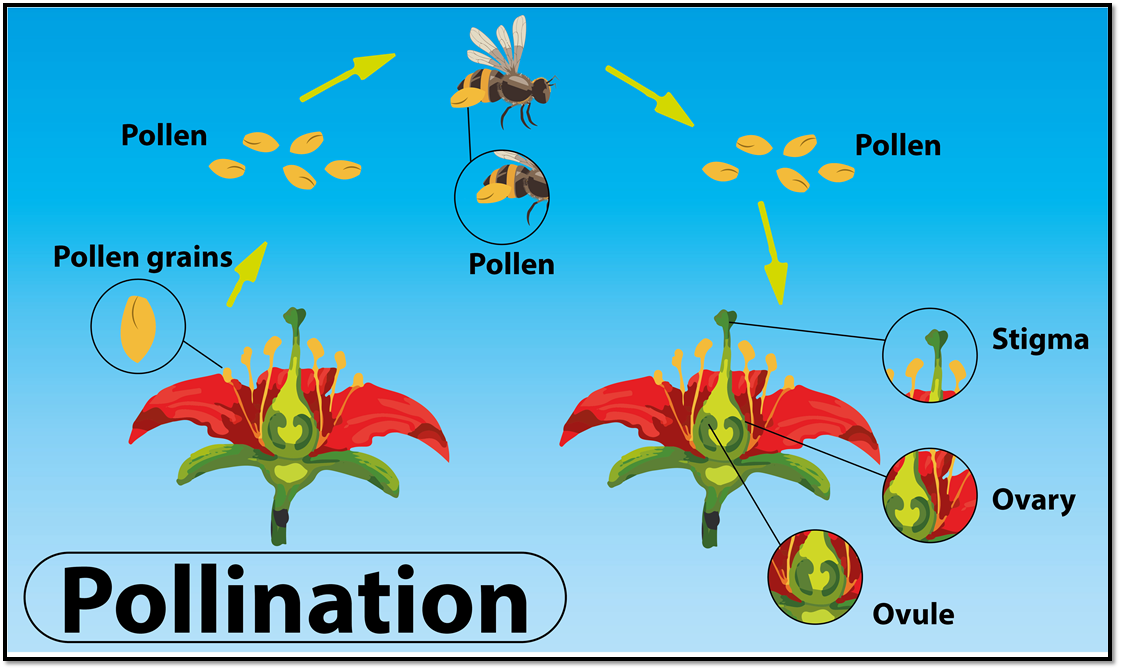
Insects visit flowers to help in pollination.
(a) True
(b) false
Answer
467.1k+ views
Hint: Some of these include bats, birds, and even land mammals, but insects are the most prevalent pollinators. Insect pollination is important for most gardens and is as easy as insects flying from flower to flower to obtain nectar, such as bees, butterflies, and wasps.
Complete answer:
Pollination is the movement of pollen from the male part of the plant (anthers) to the female part of the plant (stigma) , which allows for subsequent fertilization and seed development, typically by animals or by the wind. A very significant part of the life cycle of plants is pollination. Entomophilia or pollination of insects is a type of pollination by which insects disperse pollen from plants. The insect's main function is that of a pollinator, which means that pollen is transferred from plant to plant (or often from the same plant) , resulting in seed growth.

By visiting flowers for nectar or pollen, or typically both, many insects other than bees achieve pollination. Many do so adventitiously, but for at least some purposes, the most significant pollinators are specialists for at least parts of their life cycles. For example, males of many species of Hymenoptera, including many hunting wasps, rely as sources of energy (in the form of nectar) on freely flowering plants and also as territories to meet fertile females visiting the flowers.
Therefore, the given statement is (a) ‘True’.
Additional information: Sadly, the insect pollination process can be disrupted by several items. Too much rain or too much wind will prevent a plant and its flowers from being able to meet pollinators. In order to keep the destructive bugs away, a gardener can also put pesticides on their plants, but these pesticides can also destroy beneficial insects and also keep them out of the garden.
Note: When insects vanish from the World, in less than a century, all life will be gone. Living people are going to starve to death. Around $80\%$ of plants are pollination-dependent angiosperms (or flowering plants). The mechanism by which plants reproduce is pollination, resulting in the development of seeds that will develop into new plants.
Complete answer:
Pollination is the movement of pollen from the male part of the plant (anthers) to the female part of the plant (stigma) , which allows for subsequent fertilization and seed development, typically by animals or by the wind. A very significant part of the life cycle of plants is pollination. Entomophilia or pollination of insects is a type of pollination by which insects disperse pollen from plants. The insect's main function is that of a pollinator, which means that pollen is transferred from plant to plant (or often from the same plant) , resulting in seed growth.

By visiting flowers for nectar or pollen, or typically both, many insects other than bees achieve pollination. Many do so adventitiously, but for at least some purposes, the most significant pollinators are specialists for at least parts of their life cycles. For example, males of many species of Hymenoptera, including many hunting wasps, rely as sources of energy (in the form of nectar) on freely flowering plants and also as territories to meet fertile females visiting the flowers.
Therefore, the given statement is (a) ‘True’.
Additional information: Sadly, the insect pollination process can be disrupted by several items. Too much rain or too much wind will prevent a plant and its flowers from being able to meet pollinators. In order to keep the destructive bugs away, a gardener can also put pesticides on their plants, but these pesticides can also destroy beneficial insects and also keep them out of the garden.
Note: When insects vanish from the World, in less than a century, all life will be gone. Living people are going to starve to death. Around $80\%$ of plants are pollination-dependent angiosperms (or flowering plants). The mechanism by which plants reproduce is pollination, resulting in the development of seeds that will develop into new plants.
Recently Updated Pages
Master Class 12 Economics: Engaging Questions & Answers for Success

Master Class 12 Maths: Engaging Questions & Answers for Success

Master Class 12 Biology: Engaging Questions & Answers for Success

Master Class 12 Physics: Engaging Questions & Answers for Success

Master Class 12 Business Studies: Engaging Questions & Answers for Success

Master Class 12 English: Engaging Questions & Answers for Success

Trending doubts
Draw a labelled sketch of the human eye class 12 physics CBSE

The final image formed by a compound microscope is class 12 physics CBSE

Differentiate between homogeneous and heterogeneous class 12 chemistry CBSE

What are the major means of transport Explain each class 12 social science CBSE

Which of the following properties of a proton can change class 12 physics CBSE

What is the energy band gap of silicon and germanium class 12 physics CBSE




